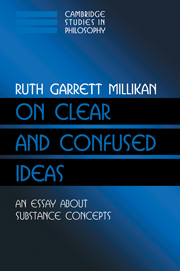Book contents
- Frontmatter
- Contents
- Preface
- Chapter 1 Introducing Substance Concepts
- Chapter 2 Substances: The Ontology
- Chapter 3 Classifying, Identifying, and the Function of Substance Concepts
- Chapter 4 The Nature of Abilities: How Is Extension Determined?
- Chapter 5 More Mama, More Milk and More Mouse: The Structure and Development of Substance Concepts
- Chapter 6 Substance Concepts Through Language: Knowing the Meanings of Words
- Chapter 7 How We Make Our Ideas Clear: Epistemology for Empirical Concepts
- Chapter 8 Content and Vehicle in Perception
- Chapter 9 Sames Versus Sameness in Conceptual Contents and Vehicles
- Chapter 10 Grasping Sameness
- Chapter 11 In Search of Strawsonian Modes of Presentation
- Chapter 12 Rejecting Identity Judgments and Fregean Modes
- Chapter 13 Knowing What I'm Thinking Of
- Chapter 14 How Extensions of New Substance Concepts are Fixed: How Substance Concepts Acquire Intentionality
- Chapter 15 Cognitive Luck: Substance Concepts in an Evolutionary Frame
- Appendix A Contrast with Evans on Information-Based Thoughts
- Appendix B What Has Natural Information to Do with Intentional Representation?
- References
- Index
Chapter 5 - More Mama, More Milk and More Mouse: The Structure and Development of Substance Concepts
Published online by Cambridge University Press: 02 December 2009
- Frontmatter
- Contents
- Preface
- Chapter 1 Introducing Substance Concepts
- Chapter 2 Substances: The Ontology
- Chapter 3 Classifying, Identifying, and the Function of Substance Concepts
- Chapter 4 The Nature of Abilities: How Is Extension Determined?
- Chapter 5 More Mama, More Milk and More Mouse: The Structure and Development of Substance Concepts
- Chapter 6 Substance Concepts Through Language: Knowing the Meanings of Words
- Chapter 7 How We Make Our Ideas Clear: Epistemology for Empirical Concepts
- Chapter 8 Content and Vehicle in Perception
- Chapter 9 Sames Versus Sameness in Conceptual Contents and Vehicles
- Chapter 10 Grasping Sameness
- Chapter 11 In Search of Strawsonian Modes of Presentation
- Chapter 12 Rejecting Identity Judgments and Fregean Modes
- Chapter 13 Knowing What I'm Thinking Of
- Chapter 14 How Extensions of New Substance Concepts are Fixed: How Substance Concepts Acquire Intentionality
- Chapter 15 Cognitive Luck: Substance Concepts in an Evolutionary Frame
- Appendix A Contrast with Evans on Information-Based Thoughts
- Appendix B What Has Natural Information to Do with Intentional Representation?
- References
- Index
Summary
EARLY WORDS FOR SUBSTANCES
The bulk of a child's earliest words are concrete nouns, including names of individuals, names of concrete kinds, and some names for stuffs (“milk,” “juice”). These are acquired in a rush by the dozens between about one and one half and two years old: “this vocabulary spurt is often called the naming explosion to reflect the large preponderance of nouns that are learned” (Markman 1991, p. 81). Adjectives come later and more slowly, and abstract nouns later still. This suggests that the ability to distinguish concrete individuals in thought and the ability to distinguish concrete kinds and stuffs may have something in common, and that concepts of properties and of other abstract objects may not be required for these tasks. There is much independent evidence that children come to appreciate separable dimensions, such as color, shape, and size, only after a considerable period in which “holistic similarities” dominate their attention (see Keil 1989, for discussion). Thus, concepts of properties again appear as less fundamental than those expressed with simple concrete nouns.
We can interpret this data as suggesting that concepts of substances are the easiest for a child to obtain, and more surprising, that the ontological distinction among individuals, real kinds, and stuffs does not produce a difference in ease of early learning. I have proposed that, despite their obvious ontological differences, individuals, real kinds, and stuffs have something important in common that bears directly on what it is to have concepts of them.
- Type
- Chapter
- Information
- On Clear and Confused IdeasAn Essay about Substance Concepts, pp. 69 - 83Publisher: Cambridge University PressPrint publication year: 2000



